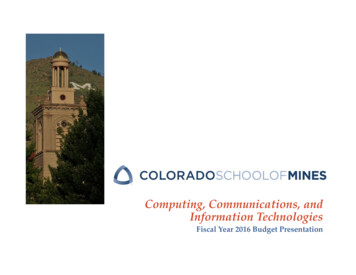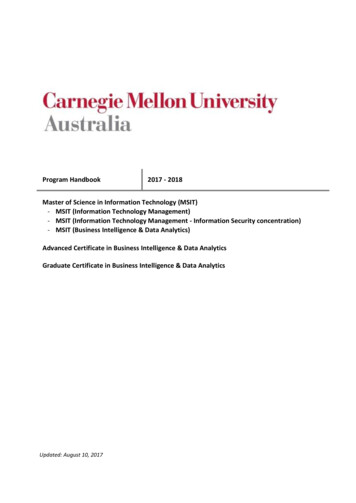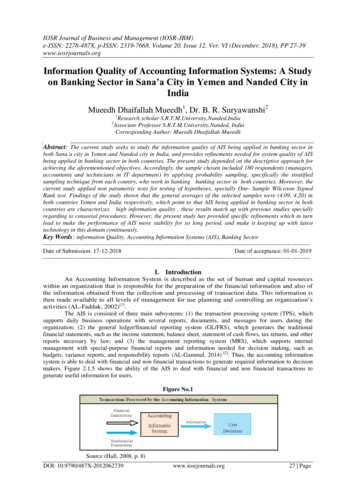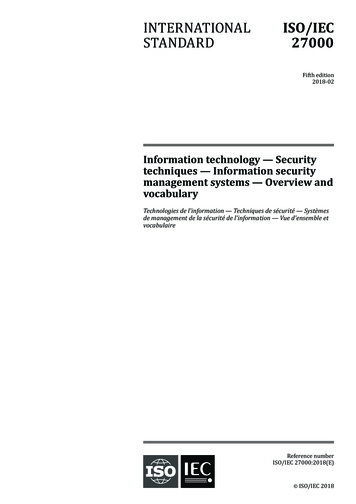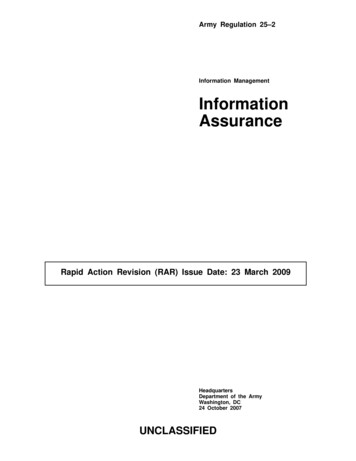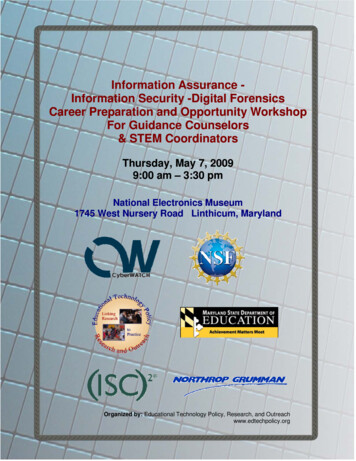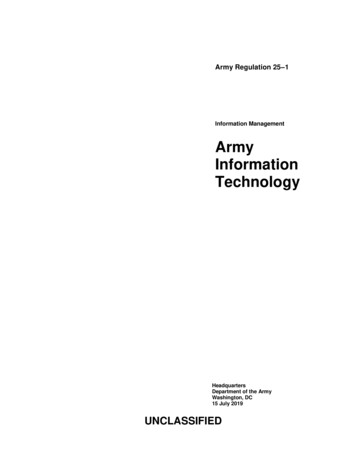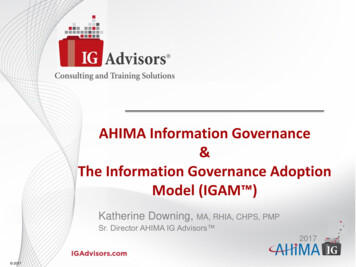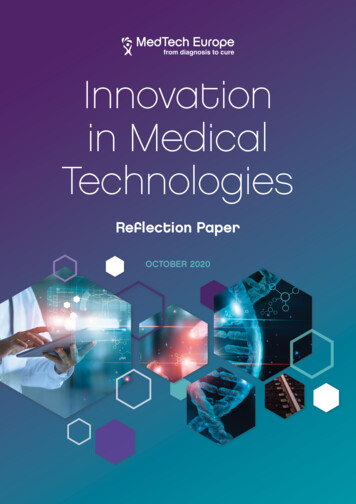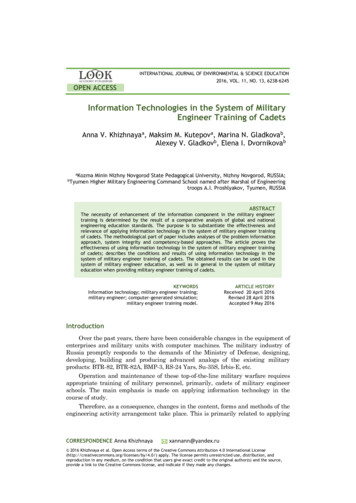
Transcription
INTERNATIONAL JOURNAL OF ENVIRONMENTAL & SCIENCE EDUCATION2016, VOL. 11, NO. 13, 6238-6245OPEN ACCESSInformation Technologies in the System of MilitaryEngineer Training of CadetsAnna V. Khizhnayaa, Maksim M. Kutepova, Marina N. Gladkovab,Alexey V. Gladkovb, Elena I. DvornikovabaKozmabTyumenMinin Nizhny Novgorod State Pedagogical University, Nizhny Novgorod, RUSSIA;Higher Military Engineering Command School named after Marshal of Engineeringtroops A.I. Proshlyakov, Tyumen, RUSSIAABSTRACTThe necessity of enhancement of the information component in the military engineertraining is determined by the result of a comparative analysis of global and nationalengineering education standards. The purpose is to substantiate the effectiveness andrelevance of applying information technology in the system of military engineer trainingof cadets. The methodological part of paper includes analyses of the problem informationapproach, system integrity and competency-based approaches. The article proves theeffectiveness of using information technology in the system of military engineer trainingof cadets; describes the conditions and results of using information technology in thesystem of military engineer training of cadets. The obtained results can be used in thesystem of military engineer education, as well as in general in the system of militaryeducation when providing military engineer training of cadets.KEYWORDSInformation technology; military engineer training;military engineer; computer-generated simulation;military engineer training model.ARTICLE HISTORYReceived 20 April 2016Revised 28 April 2016Accepted 9 May 2016IntroductionOver the past years, there have been considerable changes in the equipment ofenterprises and military units with computer machines. The military industry ofRussia promptly responds to the demands of the Ministry of Defense, designing,developing, building and producing advanced analogs of the existing militaryproducts: BTR-82, BTR-82А, BMP-3, RS-24 Yars, Su-35S, Irbis-E, etc.Operation and maintenance of these top-of-the-line military warfare requiresappropriate training of military personnel, primarily, cadets of military engineerschools. The main emphasis is made on applying information technology in thecourse of study.Therefore, as a consequence, changes in the content, forms and methods of theengineering activity arrangement take place. This is primarily related to applyingCORRESPONDENCE Anna Khizhnayaxannann@yandex.ru 2016 Khizhnaya et al. Open Access terms of the Creative Commons Attribution 4.0 International /) apply. The license permits unrestricted use, distribution, andreproduction in any medium, on the condition that users give exact credit to the original author(s) and the source,provide a link to the Creative Commons license, and indicate if they made any changes.
INTERNATIONAL JOURNAL OF ENVIRONMENTAL & SCIENCE EDUCATION6239computer-based and telecommunication technology (Gladkov, 2006; Kazantsev andPerov, 2015).The broad usage of computers in all fields of activity of a contemporaryengineer, including production management, design development, simulation,construction, production, operation of military technology raises higher demands tothe professional competence of a graduate, particularly to his IT proficiency.The technological development of the educational process in higher educationalinstitutions is the development and introduction of systems and educationalsoftware, best practices, organizational forms of training, computer technology,based on the effective organization of educational process. Specific requirements forintroduction of new technologies in the educational process are manifesteddifferentiation of training and the possibility of choosing a future profession,changes in forms and methods of organization and communication activities ofstudents and teachers, tolerance and education of youth.However, it should be noted that many theoretical and practical problems inparticular the introduction of modern information and computer technologies inteaching methodology and accounting disciplines require further investigationtoday. There remain unresolved issues that directly affect a clear justification ofeffective use of the latest computer and information technologies in teaching ofspecial subjects.Methodological FrameworkThe necessity of enhancement of the information component in the militaryengineer training is determined by the result of a comparative analysis of global andnational engineering education standards (Bernstein et al., 2016).For example, with a better fundamental component of the engineer trainingand comparable professional and special component of training, Russian schools fallbehind foreign foreign military schools in terms of computer equipment (Dolzhenkoand Shatunovsky, 1990).However, some scholars and experts worry that excessive application ofcomputers in education can affect the development of engineering qualities, such asintuition, designer’s way of thinking, ability of thorough analysis of technical objectsand processes’ properties (Kazantsev and Perov, 2015; Vaganova, 2014; Gladkovaand Gladkov, 2015; Gladkova, 2015; Markova and Gladkova, 2008; Medvedeva andMarik, 2015).A solution of this controversy can be found in developing and implementingengineering education programs, based on the system integrity approach to thestudy process organization (Tai et al., 2016).This approach is not brand new and is particularly popular in engineeringpedagogy (Kutepov, 2003).At the same time, the progressing differentiation of engineers’ activities by thetypes of works and by the subject industry attribute impedes the development of theuniversal didactic model of the military engineer training of cadets (Sun et al.,2016). Therefore, developing a didactic model of military engineer training incompliance with a particular education standard with account of the continuouslychanging information environment of a professional’s activity and regionalpeculiarities is a relevant task (Tonello, 2016).
6240A. V. KHIZHNAYA ET AL.To our opinion, the system of military engineer training of cadets who aretrained in mechanical and machine-building, electrotechnical, radiotechnical, andother majors will be effective provided the following organizational and pedagogicalrequirements are met (Smyth et al., 2016):-firstly, the strategy of special, professional and information training will bedeveloped by the graduating faculty based on a system integrity approachand will be promptly revised depending on the social demand;-secondly, IT will be applied in the pedagogical process comprehensively, as acombination of three interrelated components — study objects, tools forstudying the engineering subjects, and new education technology;-thirdly, the study of subjects will be provided continuously, stage by stage,in a sequence during the entire education period with account of theprinciples of organization of the education and information environment;-fourthly, beside the general education programs, the course schedules willinclude applied topics focused on the subject field and professionalenvironment of the future military engineer activity;-fifthly, the IT elements used in the course of study will be appropriatelycombined with the traditional technology and supported by the currenttechnical means.The state standards that are currently in effect allow implementing computerfocused personnel training technology in each particular technical higher educationschool (Scherer et al, 2016).For example, the Tyumen Higher Professional Military Engineering CommandAcademy introduced additionally a new course, Mechanical Engineer’s WorkplaceSoftware and Hardware, as well as Applied Programming, adapted to comply withthe education standards of related majors. They familiarize students with theprinciples of development of software and information support for addressingapplied tasks, computer graphic basics, rules of use of standard software andparticular professional engineering software suites.Besides, the study of such subjects as Mathematic Modeling and Optimizationof Technological Processes and Equipment, Systems of Automated DesignDevelopment is provided for cadets.However, changing only the content part of the curriculum will definitely notresult in automatic improvement in the level of information proficiency. It isrequired to develop relevant methodological and information support materials, useinnovative technology at all stages of the future military engineer training.Results and DiscussionThe difficulty in implementation of the system integrity approach in thecircumstances of a military higher educational institution resides primarily in theexistence of a considerable gap between the level of IT application in variousprofiling faculties and in the absence of a uniform methodology for theirimplementation in the education process.Experts of both military engineering higher educational institutions and otherhigher educational institutions that train engineers work to settle down this issue.To our opinion, a high level of military engineer training that would meet thedemands and prospects of development of the society, technology, production
INTERNATIONAL JOURNAL OF ENVIRONMENTAL & SCIENCE EDUCATION6241science, the Ministry of Defense and the military industry can be achieved throughcreating an integral system for military engineer training of cadets that wouldprovide: forming practical skills of use of standard software in cadets, such as theAiToSas software, the integrated system for automation of mathematical andengineering calculations Mathcad, Mathlab, etc.; studying by cadets of the methods for computer-assisted design developmentfor individual units, machines, devices, conveyors, analysis of computermodels at all stage of the design development process — from conceptualdesign to certification of finished products; studying the general regularities of design development through formation instudents of a system of knowledge and skills of stage-by-stage goal-settingand selection of methods for its goal-achievement as a basis for furthersystematic design of particular technical objects; formation in cadets of the skills of practical application of methods forcomputer engineering at the calculation and graphic work, processingexperiment results, and course and graduation design development; application of computer-based engineering, including own research anddevelopment in the field of modeling and optimal design of processes, forperformance of technical projects in collaboration with military industryenterprises.Currently, cadet training involves 3D design development, starting fromweapons and military machinery (power units ED-200/T400, BMP, etc.), engineerammunition (mines TM-89, grenades RGD and RGO, etc.), and ending with variousdevices (circuit boards, etc.) and assembly units (military vehicles, etc.).In modern conditions of development of information technologies andinformation of all the social and economic processes is a primary necessity of the useof information systems in teaching accounting disciplines. The rapid developmentand wide distribution of global computer network has identified the relevance andled to the need for the introduction of information and communication technologiesin education.The introduction of innovative approaches, information systems andtechnologies in the learning process is an important component for training cadetsprofessionals, and teachers should also remember that they are called to bring tothe students of the latest methods and forms of work that society dictates a newgeneration of professionals today in accordance with international accountingstandards, rules and principles.Information system should be viewed as a set of organizational and technicalmeans for the further preservation and processing of information in order to ensureusers' information needs.Selection and systematization of information technology, suitable for teachingspecial subjects, a separate aspect in improving the quality of the acquisition ofknowledge by students.Of great importance for the teaching of playing the visual aids that enliventeaching, make it more understandable, interesting, educationally effective andallows for minimal time more clearly present the lecture material, to separate the
6242A. V. KHIZHNAYA ET AL.important from the secondary, to focus students' attention on the details that otherconditions are not We would be assimilated and understandable.The use of electronic textbooks will not only save time in the preparation of theteacher for classes, but also effectively influence the performance of students at thetime of processing the theoretical material, case studies, work on auxiliarymaterials, the analysis of the self-knowledge, will help to achieve the expectedlearning outcomes. Visibility reflected in user-friendly form of initial andintermediate data processing ongoing and the final results, the mapping of thetheoretical and practical material: video clips, tests, practical tasks for self-analysisand self-control, to further contribute to a constant dynamic updating of methodsand forms of the electronic textbook in educational process.In view of the development of modern computer technology, special attentionshould be paid to the study of the modern hardware of computer technology andcomputer networks, process the data in information systems, communicationprograms for faxing and Internet access, multimedia technologies, electronicdocument management technologies. It is important that the expert was informedas to the methods of document security on local networks and communicationsystems: centralized data management, data security during transmission viacommunication channels.That is why the rapid introduction of modern information and computertechnology in everyday life of society served as a catalyst for the development ofinnovative processes in education linked to the introduction of forms of distancelearning. One of the conditions for the implementation of the tasks of qualitativetraining of future specialists of universities is the introduction and widespread usein the educational process of modern forms of distance learning.Distance Learning - a technology based on the principles of open learning, iswidely used for different purposes and computer training programs, and createswith the help of modern telecommunication information educational environmentfor the delivery of educational material and communication.The basis of the educational process in distance learning is purposeful andcontrolled by intensive self-study student who can learn at your own place, on anindividual schedule and the possibility of contact with the teacher. Each teacheruses their own, inherent technique, but experience shows that experts preparedusing information technology in teaching, interactive methods and informationtechnology training, become more confident and experienced accountants, do nothesitate, meeting with non-professional problems.Current pedagogical innovations associated with the use of interactive teachingmethods, that is interactive - can interact, dialogue. Interactive training - is aspecial form of organization of cognitive activity has a specific, intended purpose - tocreate a comfortable learning environment in which every student feels his success,intellectual consistency. The essence of the interactive technologies that learningoccurs through the interaction of all students. This facilitation of learning, in whichteacher and student are subjects. The teacher acts only as a training organizer,coordinator of work groups. Interactive learning technologies are most appropriatestudent-oriented approach in the educational process.Educational work is carried out by combining the listening phase controlsystem and module-rating technology of training is provided not only by the
INTERNATIONAL JOURNAL OF ENVIRONMENTAL & SCIENCE EDUCATION6243direction of students to vocational and professional training, but also responds to theprinciples of the development of their creative abilities and formation skills.Using situational approach will enable students to effectively learn themethodological and organizational approaches on accounting in the company and,most importantly, will allow to understand complex organizational approaches tothe construction of the accounting process as a whole and to study the function ofindividual employees to ensure the performance of its functions. On the other hand,this will enable the student to assess the extent of their training and their ownabilities.Information model of teaching of special disciplines can be seen as aninnovation system that helps to integrate the theoretical, methodological andpractical bases of the pedagogical process. At the same time all the components ofthis process: objectives, content, activities of students and teachers, monitoring andevaluation of learning outcomes - undergo certain changes. The process of teachingof special disciplines, based on information technology, requires a clear statement ofobjectives and monitoring their implementation. In accordance with the computerprograms, achieving the objective during teaching special subjects to be step-wise,considering hierarchical information means, methods, by which purpose and will bedetermined to be implemented at some point instruction and a certain date.Today, an important issue is to familiarize students with the applicationsoftware developments concerning the automation process of the enterprise.In our opinion, better education of students to carry out the example of complexautomation systems, such as medium-scale enterprises. These systems provide auniversal study of information technologies, including the preparation of primarydocuments, perform functions, report generation. They are today the most commonin enterprises and organizations.The study of such products should be extended to students in terms ofnumbers, it is necessary to increase the range of software products for teachingspecial disciplines. Such an approach would not limit the horizons of futureprofessionals learn functionally compare products, get acquainted with thepossibilities of the existing and future software to determine the direction of theiruse in future activities.The results of the performed studies (Gladkov, 2006; Vaganova, 2014;Gladkova and Gladkov, 2015; Dvoretsky et al., 1999; Shevchenko et al., 2014;Khizhnaya and Chervova, 2006; Ivanov, 1983; Vaganova and Khizhnaya, 2016)evidence that the use of 3D technology in education: increases the volume ofmemorized information and the rate of its processing; improves the quality andincreases the level of the study process; allows to successfully digest a huge amountof sophisticated and abstract information in an easy and comprehensible form;increases the level of the interest to study and cognition and the training activenessof the trainees; promotes the growth of professional motivation (both in teachers andstudents).Besides, applying 3D technology in the military engineer training of cadets hasthe following positive aspects: lectures become practice-oriented; at practical and laboratory classes, cadets can perform tasks using 3Dtechnology (3D videos, 3D photos, 3D presentations, etc.);
6244A. V. KHIZHNAYA ET AL. saving time for studying certain topics, which allows to use the savedtime for in-depth study of materials; optimization of the classroom stock through decreasing the workload ofspecialized classrooms.ConclusionThe polyfunctional, integrative, continuous, and multilevel nature of theprofessional military training of cadets requires applying innovative teachingmethods. Contemporary professional military training is of problem-focused nature,and the implementation of information technology allows addressing teachingprocess problems effectively.Namel
of cadets. The methodological part of paper includes analyses of the problem information approach, system integrity and competency-based approaches. The article proves the effectiveness of using information technology in the system of military engineer training of cadets; describes the cond


